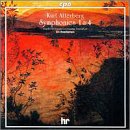| All Artists: Kurt Atterberg, Ari Rasilainen, Frankfurt Radio Symphony Orchestra Title: Kurt Atterberg: Symphonies Nos. 1 & 4 Members Wishing: 0 Total Copies: 0 Label: Cpo Records Release Date: 2/22/2000 Genre: Classical Styles: Historical Periods, Modern, 20th, & 21st Century, Symphonies Number of Discs: 1 SwapaCD Credits: 1 UPCs: 761203963928, 076120396392 |
Search - Kurt Atterberg, Ari Rasilainen, Frankfurt Radio Symphony Orchestra :: Kurt Atterberg: Symphonies Nos. 1 & 4
 | Kurt Atterberg, Ari Rasilainen, Frankfurt Radio Symphony Orchestra Kurt Atterberg: Symphonies Nos. 1 & 4 Genre: Classical |
Larger Image |
CD Details |
CD ReviewsAn very Impressive First and the Idiomatic, Engaging Fourth David A. Hollingsworth | Washington, DC USA | 03/15/2002 (5 out of 5 stars) "To my mind, Atterberg's First Symphony in B minor (1910), written when he was just under 24 years of age, is the most impressive premiere symphony written by a Swedish composer (especially of his generation). The ideas rarely flags and never ran the risk of empty rhetoric. Instead, the thematic ideas are nicely wrought and poignant. And although the orchestration leans towards Wagnerian sonority, there's clarity in the language and a sense of proportion. The first movement is especially appealing. After the heroic exposition opening, the movement gathers pace much in a tripled meter. The temperament is fiery and hints of Brahms and pinches of Bruckner are detectable. The second movement is particularly spellbinding and poetic (a sure sign of the slow movements of the succeeding symphonies that convey great depth and flair). The beginning is peaceful and solemn. But the following passages become vivid and memorable. Listen to how a particular elegiac passage (@4'05''-ff) is given the more sense of this magical, compelling wroughtfullness by the english horn (cor anglais) admirably supported by the harp arpeggios and viola solo. This is something even Dvorak and Strauss would have appreciate. The mood intensifies into something of a "Hollywoodish" grandeur before the closing of the movement in ways contemplative in feeling. Then turn to the scherzo and you'll find some very adventurous writing, with the ideas again poignant and vivid. Unlike the finales of the first symphonies of, say Alfven, Rangstrom, or Stenhammar, this finale is nicely held together. I admire the way he starts the first four minutes of the movement (adagio) with the compelling yet restrained expressionism of the second movement. The character is imaginative and noble and while I dreaded for the following allegro energico to be banal and empty,....I was relieved by the fact that the opposite was true. The finale comes short of being episodic even though the development did not go as far as one might have expected. However, Atterberg convinces me of a composer capable of grasping one's attention. Small wonders then that prominent conductors after the 1912 Goteborg premiere promoted this abundantly inventive score, including Leopold Stokowski and Carl Nielsen (who may have thoughts of his own rigorous, highly original first symphony written roughly two decades earlier). The Fourth Symphony in G minor (1918) is a highly an engaging, resourceful work, with the ideas witty and virtuosic. Listening to the first movement, I sense something of Sibelius and perhaps of Ravel and Poulenc in much of the string writing with the mood Nordic but somewhat impressionistic. The second movement is enchanting, with the muted, highly concentrated strings accompany by the clarinet solo. Then turn to the english horn and flute solos (3'35''-ff) and the mood is even more impressionistic, but something remotely Baxian in temperament that has magic and wonder (and I'm thinking of Bax's "Nympholept" not in terms of the orchestration, but in terms of the melodies that are haunting, a sort of "one who's entering the enchanting woods during the spring, amazed by density of the trees and the streams which began to show life after a long winter"). The scherzo is sort of neoclassical in design; A Sodermanland polka at the beginning followed by the trio using the Vastmanland polka. The finale is likewise engaging and its' melodic profiles are characteristic. It's again very idiomatic and imaginative and the ending has a sort of Nielsenian sarcasm to it that I actually laughed (out of enjoyment, mind you). The Symphony is altogether a flawless work and my admiration towards it will continue to grow. The First, meanwhile, is a mighty strong, rewardingly inventive score that also deserve live concert performances. Atterberg was among the more successful of Scandinavian composers and with good reasons. Ari Rasilainen and the Frankfurt Radio Symphony, judging from their authoritative, enthusiastic performances, concur emphatically." Highly enjoyable Paul Graziano | Burlington, VT United States | 10/25/2003 (5 out of 5 stars) "There's not much to for me to say here. Both should be enormously appealing for anybody who loves the Romantic symphony. The melodies and thematic ideas are inspired and nicely developed, orchestration colorful and clear. There's nothing groundbreaking here. As other reviewers have stated, there's a little Brahms here, some Sibelius there, a dabble of Dvorak, etc, but Atterberg has assimalted some of the best qualities of each and the music never sounds self-conciously derivative or incongruent, and it should please just about everybody."
|
